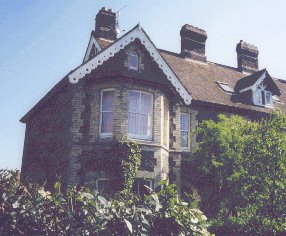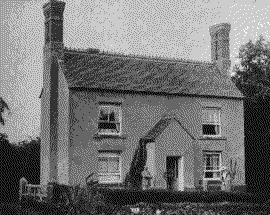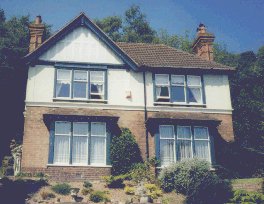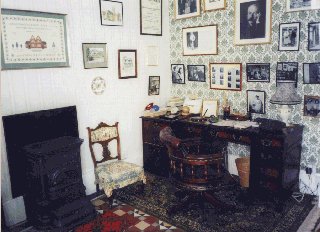|
During his lifetime, from the
Birthplace Cottage at
Broadheath to Marl Bank, his home in Worcester for the last years of his life, Elgar lived in some
twenty-five houses or flats. And this does not include the numerous houses of close friends -
notably Frank Schuster's house, The Hut, at Bray in Berkshire - that he often
stayed at as a house guest, sometimes for months at a time. The large number of properties and
the impression of a restless soul always on the move is often represented as one of the
psychological complexities of Elgar's character. It is true that the inspiration from which his
compositions sprang was highly dependent on his surroundings, and two of the properties -
Birchwood, at Storridge near Malvern, and Brinkwells, near Fittleworth in the
Sussex countryside - was rented to provide the rural environment, close to nature, that Elgar
found so conducive to composing. But a closer examination of the reasons for each move shows
that none were made on a whim. Indeed, like most of us, Elgar detested the upheaval and
disruption of moving house and left the bulk of the work - the finding and viewing of suitable
properties, negotiating the lease or purchase, organising the packing, removal and unpacking -
to his wife Alice.
 |
| The Birthplace Cottage
|
|
Elgar's parents had rented the Birthplace Cottage, at that time called The Firs, in 1856. Elgar's father William had an established music
business in Worcester, some three miles from Broadheath, and only spent weekends at the
cottage. It seems that the cottage in the Worcestershire countryside was the choice of Elgar's
mother Ann who, having some artistic talent and an affinity with nature, preferred her children to
grow up in rural surroundings. Edward had an elder brother, Harry, and two elder sisters, Lucy
and Pollie, so that Edward's arrival swelled the number of the cottage's occupants to six. With
another addition to the family (Joe, born in 1859) expected, the family was clearly about to
outgrow the cottage so William and Ann sought a larger home in Worcester. From 1859 to 1861,
they lived at 1 Edgar Street before returning to 2 College Precincts, a three-story house still
standing near the Cathedral, where they had lived for eight years before moving to Broadheath.
Then in 1863 they moved to 10 High Street, to live above the shop that housed the family music
business. It was here that Edward received his initial grounding in the various aspects of music
making that were to substitute for a formal musical education. The shop has now been
demolished but the Gifford Hotel carries a plaque to mark the approximate location of the
shop.
 |
The Shop at
10 High St, Worcester
|
|
Edward remained at 10 High Street until 1879 when he moved in with his sister Pollie and
her husband William Grafton at Loretta Villa, 35 Chestnut Walk, Worcester. This was the period
when Edward's compositional talents were first beginning to show through, the period of the wind quintet for which he attempted to provide a new
composition or arrangement each weekend. While Elgar claimed to have composed his wind
quintet music during sermons in the organ loft at St George's church, it seems improbable, given
the effort required, that he could have done so and therefore likely that many of the compositions
from around 1880 were composed in sister Pollie's house. The house, now renumbered 12
Chestnut Walk, still stands two minutes walk east of the town centre.
In 1883, the Graftons moved to Stoke Works near Bromsgrove, so Edward took up residence
at 4 Field Terrace, Worcester, the home of his eldest sister Lucy and her husband Charles Pipe.
Field Terrace runs off the Bath Road a short walk south of the city centre. Here Elgar was to
remain until his marriage to Alice in 1889.
At the time of their marriage, Alice was already renting a property,
Saetermo, in Great Malvern, but Elgar believed he could only make his name
through a closer involvement in the London musical scene. This meant taking up residence in
London. Their marriage was thus followed by a period of domestic turmoil as Elgar tried - and
eventually failed - to establish himself in the capital. After honeymooning at Ventnor in the Isle
of Wight, they took a short lease on a property in Marloes Road, West Kensington. When that
lease ran out, and with little income, they returned to Malvern to live first at
Saetermo, where a few months of Alice's earlier lease remained unexpired, and
then for two weeks at a nearby property in The Lees.
In October, they returned to London, to Upper Norwood, close to Crystal Palace which at
that time saw regular orchestral concerts at which Elgar hoped to get his compositions played,
and then, with Alice pregnant with Carice and needing a larger flat, to West Kensington. But the
winter was bitter, Edward was making little headway in establishing himself in London and it was
clear that he could make a better living, if not in the manner of his choosing, by teaching the violin
back in his native Worcestershire. After a year of hardship in West Kensington, Edward
advertised his availability to give violin lesson in Worcester and prepared to return home.
.
 |
| Forli
|
|
This they did in March 1891, lodging for a few weeks at 4 The Lees while they looked for
a more suitable property. They found a solid semi-detached house up a short track off Alexandra
Road at Malvern Link, at the Worcester end of Malvern, which they named Forli. It
provided a stable environment for Elgar almost to the end of the century. Here he completed The Black Knight, revised and published the Serenade for Strings, and composed Scenes from the Bavarian Highlands , The Light of Life, King
Olaf, The Banner of St George, much of Caractacus, and the Enigma
Variations, an impressive list of works which reinforced his local reputation and
expanded it into a national one.
 |
| The Elgars outside Birchwood
|
|
But despite the music that flowed from Forli, Elgar found it lacking in one important
respect : it was essentially an urban property. Despite its proximity to the Malvern Hills and the
Worcestershire countryside, it had clear views of neither. Elgar found the countryside - the peace
and quiet, the views, sounds and smells - inspiring and, early in 1898, began to look for a cottage
in the countryside to use as a retreat from the pressures and disturbances of Malvern. The
property they found, at Great Storridge, some four miles north west of Forli and just across the
border into Herefordshire, was Birchwood Lodge. Elgar loved Birchwood beyond any
of his other homes apart from the Birthplace itself. His letters to Jaeger frequently refer to the sense of escape he
found there. He had a Broadwood piano installed in a bedroom in April 1898. Here he
completed Caractacus, itself set among the hills that
Elgar could now gaze upon from his study window, four of the Sea Pictures (In Haven, the second of the songs,
having been composed two years earlier) and essentially the whole of The Dream of Gerontius.
 |
| Craeg Lea
|
|
In 1899, possibly motivated by Edward's increasing fame and a desire to reflect that status,
the Elgars decided to quit Forli for something grander. They chose a house on the Wells Road
about a mile south of the centre of Malvern. They named the house Craeg Lea, an
anagram of C(arice), A(lice) and E(dward) Elgar. The
substantial house is set on a bank high above the Wells Road and, as at Birchwood, Elgar chose
a room on the upper floor for his study, giving him tremendous views across the Severn Valley
and the Worcestershire countryside. But, despite the obvious attractions of Craeg Lea, the choice
was perhaps a mistake.
 |
| Craeg Lea - interior view
|
|
Firstly, Craeg Lea is a good deal further than Forli from Birchwood. As fame brought
increasing demands on his time, Edward found it increasingly more difficult to get away to
Birchwood, which remained his first love. Eventually, Edward accepted the folly of renting a
property they rarely visited and relinquished their use of Birchwood in October 1903. Within a
few months, however, the Elgars got wind of a proposed property development across the road
from Craeg Lea which Edward feared would ruin the views from his study window. It is clear
to anyone visiting Craeg Lea today that Edward's fears were totally unfounded - the views remain
spectacular. But the Elgars did not wait to find out. Betraying his lingering feelings for
Birchwood, Edward made enquiries to see if it would be possible to purchase the cottage, but was
told that it was not for sale. They therefore looked elsewhere and eventually settled on Plas
Gwyn, a house on the eastern outskirts of Hereford.
The choice was a rather odd one. Although a rather grand house on the edge of the city, it
is set back from the road in enclosed grounds, with little by ways of views. And for a now well
established national personality with heavy commitments in London and the main provincial
centres, Hereford is an even less convenient base than Malvern. But perhaps therein lay the
attraction, providing something of the isolation Edward needed to continue composing. If so, it
proved to be a notably successful choice, for here Elgar completed The Kingdom, arranged the Wand of Youth suites, and composed both symphonies, the
violin concerto, the Introduction and Allegro for
Strings, two more Pomp and Circumstance
Marches and a mass of smaller works. Not since Forli had Elgar produced so many
works from the same house.
But the strain of constant travelling to and from London and prolonged periods away from
home was beginning to tell. From March 1910, the Elgars rented a series of flats in Central
London as pieds-à-terre for Edward's commitments in the capital. And in the latter
months of 1911, they eventually decided that the only satisfactory solution was to take up
permanent residence in London. Alice Stuart-Wortley, Elgar's Windflower, helped them find a suitable house
-
42 Netherhall Gardens, off Finchley Road in Hampstead, North West London. They moved in
on New Year's Day 1912.
The house, an imposing mansion in Queen Anne style, they called Severn House.
It had its own music room large enough to hold a recital for a small audience, and Edward turned
another room into a billiard room. It was probably the dream house to which Alice had always
aspired, but it was a huge drain on their finances, forcing Edward to take on extensive conducting
engagements to pay the mortgage. And though the house's surroundings were in those days
surprisingly rural, the house was also conveniently placed for an endless stream of visitors from
Central London. This in part explains Elgar's limited output from Severn House. The wartime
conditions for a significant part of their time there, and Edward's determination to play his part
in the local war effort, first as a special constable then in the Hampstead Home Guard (then called
the Volunteer Force), did not help. And so, as the war dragged on into its third year, Alice,
accompanied by Carice, set out to find another country retreat, to serve Severn House as
Birchwood had served Forli.
The retreat they found was a cottage deep in the Sussex countryside near Fittleworth. It had
wonderful views and plenty of woods nearby for Edward to walk in. It was called
Brinkwells. Elgar loved it, and in quick succession composed the violin sonata, string
quartet and the piano quintet (although much
of the cello concerto was composed at Severn House).
But the pleasure was short-lived. While they were at Brinkwells, Severn House was burgled. In
Summer 1919, they returned from Brinkwells to find that a neighbour had begun building a garage
close to the music room of Severn House. They admitted to themselves that they could not afford
both properties and put Severn House up for sale. Alice, now turned seventy, was becoming
increasingly frail and, after a succession of minor illnesses, took to her bed in March 1920. She
died the following month.
Elgar was naturally distraught. As with Birchwood some twenty years earlier, he sought to
buy Brinkwells but, after some prevarication, the landlord decided not to sell. Elgar relinquished
his use of Brinkwells in August 1921 and of Severn House later the same year. At first, he
remained in London, taking a flat in the West End. But the withdrawal from public life following
Alice's death reduced his commitments in London, his links with Worcestershire remained strong
and, perhaps above all, he had Alice buried in St Wulstan's Church, Little Malvern, a
short distance down the road from Craeg Lea. In April 1923, he returned to live out his
remaining years close to his roots.
He first took out a lease on Napleton Grange, another rather grand mansion at
Kempsey, close to the Severn below Malvern. In Autumn 1923, he went on a cruise
up the River Amazon. He continued to live a somewhat peripatetic existence, spending extended
periods at friends' houses where he composed spasmodically. He became a regular race-goer and,
with his close friend Billy Reed, took to revisiting the places of his youth which continued to hold
sentimental attractions for him. He always attended the Three Choirs festival, regularly
conducting performances of his own works. And yet he remained inwardly lonely and
unsettled.
In the latter half of 1927, he relinquished the lease on Napleton Grange. He moved first into
Worcester renting Battenhall Manor, on a hill a short walk to the south-east of the city
centre, then, five months later, to Tiddington House, Stratford-on-Avon, where he was
able to attend performances of Shakespeare plays at the memorial theatre. Two more
grand mansions, but neither of them could Elgar truly call 'home'. And so, in December 1929, he
bought Marl Bank, a large house of solid appearance set on a bank to the east of the city
centre with a good view of the cathedral.
With the passage of time and the acquisition of a more permanent home, Elgar appears to
have regained the inspiration to compose, for the music began to flow again : the Severn Suite, a fifth Pomp
and Circumstance March, the Nursery Suite
together with a number of shorter salon pieces. And an opera - The Spanish Lady - and a Third Symphony were to follow. But it was not to be for,
in October 1933, Elgar was diagnosed as having terminal cancer.
He spent much of his last few months in a Worcester nursing home, often drifting in and out
of consciousness, but on 1 January 1934, his doctors allowed him to return home to Marl Bank
to live out his remaining days. Here, on 22 January, he made a unique contribution to a recording
session taking place at EMI's Abbey Road studio over 100 miles away. Telephone lines
were laid from the recording studio to Elgar's bedside to allow him to hear the orchestra
rehearsing and recording excerpts from Caractacus, and
to feed back comments on their playing. Three weeks later, he died in the same room.
Marl Bank and Severn House have since been demolished, but many of the other properties,
including Chestnut Walk, Forli, Birchwood, Craeg Lea, Plas Gwyn, Brinkwells and, of course the
Birthplace itself survive in much their original condition.
A well-signposted Elgar Trail has been constructed linking most of the surviving
properties and other locations associated with Elgar in the Worcester, Malvern and Hereford area
- a leaflet describing the Trail can be obtained from Tourist Information Offices in the area. And
the late Gordon Lee's Elgar website provides a
pictorial guide to many of the places that Elgar loved to visit.
|